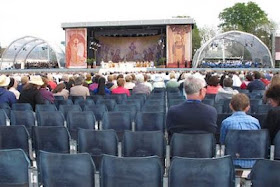The setting for the main Masses today
(I couldn't help noticing that there were rather a number of empty chairs)
This week sees the 50th International Eucharistic Congress taking place in Dublin. I'm sure that there must be plenty of good things going on there (I hope so) although having seen some of the televised Masses, I'm not sure how uplifting I would have found them if i'd been there. For example, the ladies wafting around open bowls of incense as they danced through the congregation.
The setting for Mass in Dublin's last Eucharistic Congress in 1932.
I recalled that last year someone involved with the Congress from Ireland told me that the Archbishop of Dublin had "forbidden" any talks on Eucharistic Adoration. I looked at the web-site of the Congress and found that there are, in fact, times of Exposition of the Blessed Sacrament with adoration and prayer. However, looking through the extensive programme of talks, I couldn't see any talks on Adoration of the Blessed Sacrament. Perhaps I've missed them and am wrong and someone who is actually there could put me right. It does strike me as a little odd, as many of the thriving new communities in the Church are very focused on Adoration and indeed, Perpetual Adoration, of the Blessed Sacrament. Indeed, the Holy Father was speaking about this on Corpus Christi last week - a theme he has returned to quite often.
At International Eucharistic Congresses there should be a place set aside where the Blessed Sacrametn is adored throughout the time of the Congress. Not an ancient injunction by any means, but one approved by Pope Paul VI on 13th April 1967 in the wake of the Second Vatican Council in the Instruction on Eucharistic Worship from the Congregation of Sacred Rites, emphasising also the place of "solemn processions".
VI. Eucharistic Congresses67. In Eucharistic congresses Christians seek to understand this mystery more deeply through a consideration of its many aspects. But they should celebrate it in accordance with the norms of the Second Vatican Council and should venerate it through devotions and private prayers, especially by solemn processions, in such a way that all these forms of devotion find their climax in the solemn celebration of Mass.
For the duration of the Eucharistic congress of an entire region, it is fitting that some churches should be reserved for perpetual adoration.
In the audience granted on the 13th of April, 1967, to His Eminence Arcadio M. Cardinal Larraona, Prefect of the Sacred Congregation of Rites, His Holiness Pope Paul VI, by his authority approved and confirmed this instruction, ordered that it should be published, and established that it should come into effect on the feast of the Assumption of the Blessed Virgin Mary, 15 August 1967.
All things to the contrary notwithstanding.
The ubiquitous (off centre) logo for today
The logo from the last Eucharistic Congress in Dublin in 1932





AS well as the contrast in Logos it is salutary to look at the musical differences. My mother attended the 1932 Congress with an English Diocesan group. I still have her Congress Hymnbook. Adoro te devote, Lauda Sion, Missa de Angelis, Veni creator etc. Obviously the people were expected to join in. The Lauda Sion was not Plainsong but the Lourdes setting - some music from Lourdes was included at last Sunday's Mass.
ReplyDeleteUnfortunately, most faithful and knowledgeable Catholics stayed away because of the many speakers who espouse heresy and disobedience, non-Catholics who do not recognise the Blessed Sacrament giving talks, and many expected and fulfilled liturgical abuses. To top it all some prominent Media persons and attackers of the Church and fundamental Faith and Morals are actually "presenting" the various events - the worst amongst them is to present the big shobiz finale in a huge football stadium. I suffer to think of the abuses and irreverence for the Blesses Sacrament that will take place there. There are of course Orthodox speakers but the whole presentation shows a pervasive heterodoxy. This is down to the Bishops. Thankfully, there has been some authentic Catholic doctrine, liturgy etc at the "fringe festival" which one could safely attend without being scandalised. I was so ashamed to see the prohibited intinction of the Body of Christ by communicants transmitted around the world.
ReplyDelete